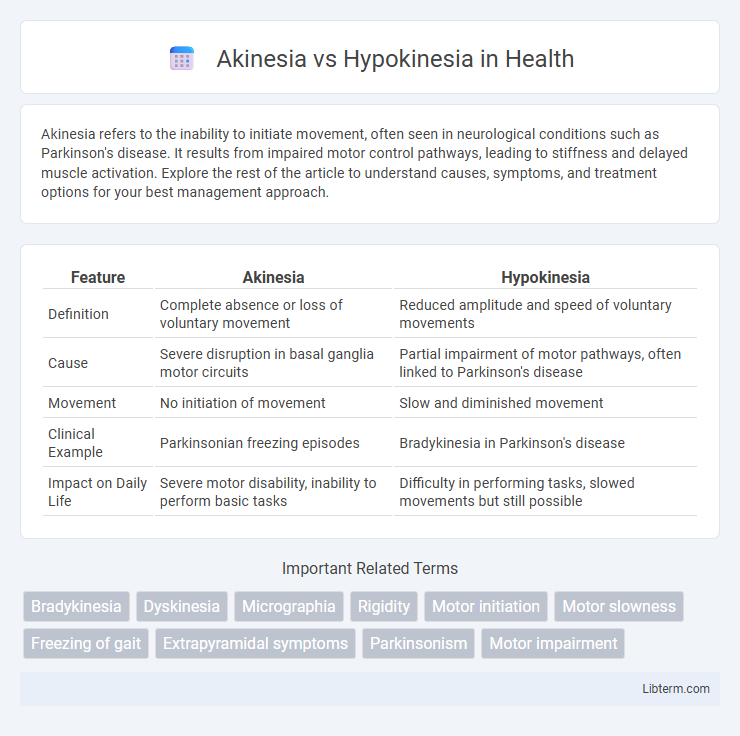Akinesia refers to the inability to initiate movement, often seen in neurological conditions such as Parkinson's disease. It results from impaired motor control pathways, leading to stiffness and delayed muscle activation. Explore the rest of the article to understand causes, symptoms, and treatment options for your best management approach.
Table of Comparison
| Feature | Akinesia | Hypokinesia |
|---|---|---|
| Definition | Complete absence or loss of voluntary movement | Reduced amplitude and speed of voluntary movements |
| Cause | Severe disruption in basal ganglia motor circuits | Partial impairment of motor pathways, often linked to Parkinson's disease |
| Movement | No initiation of movement | Slow and diminished movement |
| Clinical Example | Parkinsonian freezing episodes | Bradykinesia in Parkinson's disease |
| Impact on Daily Life | Severe motor disability, inability to perform basic tasks | Difficulty in performing tasks, slowed movements but still possible |
Understanding Akinesia: Definition and Overview
Akinesia, characterized by the inability to initiate voluntary movements, is a key motor symptom often associated with Parkinson's disease and other neurological disorders. It differs from hypokinesia, which refers to the reduction in the amplitude and speed of movement rather than a complete absence of movement initiation. Understanding akinesia involves recognizing its impact on daily activities, including difficulty in starting actions like walking or speaking, caused by impaired basal ganglia function.
What is Hypokinesia? Key Concepts Explained
Hypokinesia refers to a reduction in the amplitude or range of voluntary movements, often seen in neurological disorders such as Parkinson's disease. It is characterized by slowed or diminished movement but not a complete absence of movement, distinguishing it from akinesia, which indicates a total lack of movement. Key concepts include bradykinesia (slowness of movement), muscle rigidity, and motor control deficits impacting daily activities.
Akinesia vs Hypokinesia: Core Differences
Akinesia is characterized by the complete absence or inability to initiate voluntary movement, whereas hypokinesia involves a marked reduction in the amplitude and speed of movements without total cessation. Akinesia often manifests as a freezing phenomenon in Parkinson's disease, while hypokinesia presents as general slowness and diminished movement range. Understanding these distinctions is crucial for accurate diagnosis and tailored treatment strategies in movement disorders.
Common Causes of Akinesia
Akinesia, characterized by the inability to initiate movement, commonly results from neurodegenerative disorders such as Parkinson's disease, where dopaminergic neuron loss in the substantia nigra impairs motor function. Other causes include medication-induced akinesia, especially from antipsychotics that block dopamine receptors, and acute brain injuries affecting the basal ganglia. Hypokinesia, marked by reduced movement amplitude and speed, often co-occurs with akinesia but primarily reflects diminished motor activity rather than complete movement absence.
Typical Causes of Hypokinesia
Hypokinesia is primarily caused by neurodegenerative disorders such as Parkinson's disease, where the loss of dopamine-producing neurons in the substantia nigra leads to reduced motor activity. Other typical causes include medication-induced parkinsonism, vascular parkinsonism, and certain metabolic conditions that impair motor function. Unlike akinesia, which involves the complete inability to initiate movement, hypokinesia is characterized by slowness and decreased amplitude of voluntary movements.
Clinical Symptoms: Comparing Akinesia and Hypokinesia
Akinesia is characterized by a complete inability to initiate voluntary movement, often seen in advanced Parkinson's disease, while hypokinesia refers to a reduction in movement amplitude and speed, leading to slow, diminished motion. Clinically, akinesia presents as a freezing phenomenon or motor blocks, whereas hypokinesia results in reduced facial expression and impaired gesturing. Both conditions impact motor function but differ in severity and presentation, crucial for differential diagnosis and targeted therapeutic strategies.
Diagnostic Approaches for Movement Disorders
Akinesia and hypokinesia, both characterized by diminished motor function, are diagnosed through comprehensive clinical evaluations, including detailed patient history and neurological examinations assessing movement initiation and amplitude. Advanced diagnostic tools such as video-based motion analysis, electromyography (EMG), and neuroimaging techniques like DaTscan SPECT imaging help differentiate these conditions by revealing abnormalities in dopaminergic pathways and muscle activation patterns. Biomarker analysis and response to levodopa challenge tests further refine the diagnostic accuracy, facilitating targeted treatment strategies in movement disorders like Parkinson's disease.
Treatments for Akinesia and Hypokinesia
Treatments for akinesia primarily involve dopaminergic therapies such as levodopa and dopamine agonists to restore motor activity by enhancing dopamine levels in the brain. Hypokinesia management also includes these medications but may be supplemented with physical therapy and deep brain stimulation to improve motor function and mitigate rigidity. Both conditions benefit from tailored rehabilitation strategies aimed at improving mobility and daily functioning.
Prognosis and Management Strategies
Akinesia, characterized by a complete inability to initiate movement, generally indicates a more severe neurological impairment compared to hypokinesia, which involves reduced movement amplitude but preserved initiation. Prognosis for akinesia is often poorer, requiring aggressive management including dopaminergic therapies and advanced interventions like deep brain stimulation to improve motor function. Hypokinesia responds favorably to physical therapy, medication adjustments, and lifestyle modifications aimed at enhancing mobility and quality of life.
Frequently Asked Questions on Akinesia vs Hypokinesia
Akinesia refers to the complete absence or significant difficulty in initiating voluntary movements, while hypokinesia involves a noticeable reduction in the amplitude or speed of movement but not a total lack of movement. Frequently asked questions often address the differences in symptoms, causes--such as Parkinson's disease--and treatment options, highlighting that akinesia is more severe and disabling compared to hypokinesia. Understanding these distinctions helps guide effective clinical diagnosis and management strategies.
Akinesia Infographic

 libterm.com
libterm.com